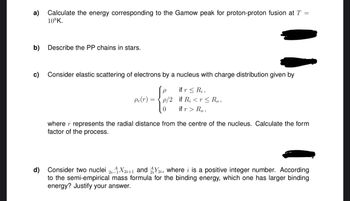Question

Transcribed Image Text:a)
Calculate the energy corresponding to the Gamow peak for proton-proton fusion at T =
108K.
b) Describe the PP chains in stars.
c) Consider elastic scattering of electrons by a nucleus with charge distribution given by
if r Ri,
Pe(r) =
= p/2
0
if Ri<r≤ Ro,
if r > Ro,
where r represents the radial distance from the centre of the nucleus. Calculate the form
factor of the process.
d) Consider two nuclei 2i4X2i+1 and 2, where i is a positive integer number. According
to the semi-empirical mass formula for the binding energy, which one has larger binding
energy? Justify your answer.
Expert Solution
This question has been solved!
Explore an expertly crafted, step-by-step solution for a thorough understanding of key concepts.
Step by stepSolved in 2 steps with 7 images

Knowledge Booster
Similar questions
- Use the semiempirical mass equation to compute, for given A, the relation between Z and N for a nucleus that has Sn 4 0 (the neutron "drip line"). Compute N/Z for A 4 100.arrow_forward5 Answer the following questions: a) For a homogeneous nucleation process, sketch the dependence of the surface and bulk free energies on the radius of a spherical embryo using the equation below. kT AG, = 4rv*y -* inS V, AG > r b) Sketch the dependence of the free energy changes (AG,) on the radius of a spherical embryo when the supersaturation ratio (S) is greater than 1, equal to 1 and less than 1. AG c) Discuss the importance of supersaturation on precipitationarrow_forwardA 2-stage rocket is fired from rest. Its acceleration data are shown in the graph below. Plot the v-t and s-t graphs describing the motion of the rocket-clearly showing the shape of the curve (or add a note) and values at inflection points. Show any calculations as well. Then find the velocity of the rocket and its elevation after 20 seconds of flight. a (m/s?) 25 18 (s) 15 20arrow_forward
arrow_back_ios
arrow_forward_ios